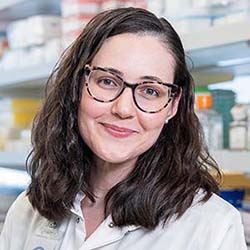Integrating Clinical Cytokine Profiling and Animal Modeling to Reduce HLH-Associated Toxicity and Improve Immunotherapy Survival
Harnessing immunoregulatory therapies to influence individual responses to immune-targeting treatments
Technology Overview

Dr. Heather Gustafson
Bioengineer Heather Gustafson, PhD, profiles the human immune milieu to establish a patient's health status and immune setpoint. The resulting clinical data not only predict a patient's clinical outcome but also are the basis for creating innovative animal models. Among the models are mice that recapture the natural variability of the human immune system. These mice can be made to resemble a patient's own immune system, to promote successful immunotherapy.
Dr. Gustafson's research demonstrates that a patient's individual inflammation setpoint influences immunotherapy outcomes, including nonresponse and dangerous side effects such as hyperinflammation, cytokine storms and neurotoxicity. These results led to work using clinical data and patient-mimicking, humanized transgenic, and syngeneic mice to identify immune-modulating drugs — including existing treatments such as those used for granulocytic-driven diseases — to administer before immunotherapy. This approach blocks toxicity pathways in advance and nudges a patient’s immune system toward a positive response. The animal models are also useful for investigating therapeutic constructs for potential toxicities and potency enhancement.
Dr. Gustafson has some of the only animal models for studying the hyperimmune response HLH (hemophagocytic lymphohistiocytosis) following immunotherapy. Her syngeneic/humanized mice that mimic individual patients' immune systems can be used to prescreen clinical trial candidates for potential life-threatening reactions.
The Gustafson lab leverages large-scale omics technologies, specifically cytokine proteomics and machine learning, to identify patient profiles associated with beneficial or adverse immunotherapy outcomes. Their findings underscore the importance of IL-18 as a master regulator of the immune system. With its dual role in promoting pathogenic responses and tumor regression — as well as its exacerbation of conditions such as asthma, allergies and tumor growth — IL-18 presents a unique opportunity for therapeutic targeting. Dr. Gustafson's work on IL-18 bridges therapeutic strategies across cancer, autoimmune diseases, infectious diseases (such as influenza and COVID), and allergy and asthma.
Dr. Gustafson has collaborated on multiple pediatric and adult clinical trials, contributing expertise in pharmaceutics, pharmacokinetics, and pharmacodynamics, including with chimeric antigen receptor (CAR) T cells. Her partnership experience includes developing animal models with The Jackson Laboratory, UT Health San Antonio, Fred Hutch Cancer Center, Mayo Clinic, Pacific Northwest National Laboratory, and Seattle Children's Therapeutics. She seeks partnerships to further develop using cytokine profiling and animal models to tailor pretherapeutic treatment to ensure positive immunotherapy responses and increase clinical trial safety.
Stage of Development
- Preclinical in vitro
- Preclinical in vivo
- Clinical predictive biomarkers
Partnering Opportunities
- Sponsored research agreement
- Collaborative research opportunity
- Clinical trial collaboration
- Consultation agreement
Publications
- lston AB, Lin Z, Gustafson HH, et al. Challenging traditional ADME assumptions for physiologically based pharmacokinetic models for intravenous administration of iron-carbohydrate nanomedicines: Potential utility of gold nanoparticle models as a roadmap. Clin Pharmacokinet. 2025. Online ahead of print.
- Burleigh K, Stratton KG, Smith JL … Gustafson HH. Low peripheral blood counts and elevated proinflammatory cytokines signal a poor CD19 chimeric antigen receptor T-cell response in acute lymphoblastic leukemia. Transplant Cell Ther. 2025;31(8):551-564.
- Lee W, Rose D, Parry B … Gustafson H, et al. Using PBMC-humanized mice to identify optimal autologous CAR T products for maximized efficacy and minimized toxicity at an individual level: a study of CD19, CD22, and CD19x22-specific constructs in multiple PBMC donors. Cancer Res. 2025;85 (8_Supplement_1): 7265.
- Lee W, Rose D, Gustafson H, et al. PBMC-humanized mouse model to assess individual variability in efficacy and toxicity of universal CD19 chimeric antigen receptor T cell immunotherapy. 2023; 142(Suppl.1);2084.
- Yang G, Yao L-C, Gustafson H, et al. Development of a novel solid tumor-bearing humanized animal model for simultaneously evaluating the toxicity and efficacy of bispecific T cell engager. Blood. 2023;142(Suppl. 1):6837.
- Assessing individual variability in efficacy and toxicity of autologous and allogeneic chimeric antigen receptor T-cell immunotherapy using a PBMC-humanized mouse model. Cancer Res. 2023;83(7_Suppl.): 4096.
- Pinto N, Albert CM, Taylor MR … Gustafson HH, et al. STRIvE-02: A first-in-human phase I study of systemically administered B7-H3 chimeric antigen receptor T cells for patients with relapsed/refractory solid tumors. J Clin Oncol. 2024;42(35):4163-4172.
- Lee W, Rose D, Cheng M … Gustafson H, et al. In vivo PBMC-humanized mouse model to assess individual variability in efficacy and toxicity of autologous and allogeneic chimeric antigen receptor T-cell immunotherapy. Blood. 2022;140(Suppl.1):10267-10268.
- Buleigh K, Kus A, Long A … Gustafson H. Poor clinical outcome in pediatric immunotherapy is mediated by a pre-existing overactive IL-18-IFNy immune phenotype. Blood. 2021; 138(Suppl. 1):168.
- Gustafson HH, Holt-Casper D, Granger D, et al. Nanoparticle uptake: the phagocyte problem. Nano Today. 2015;10(4): 487-510.
Learn More
